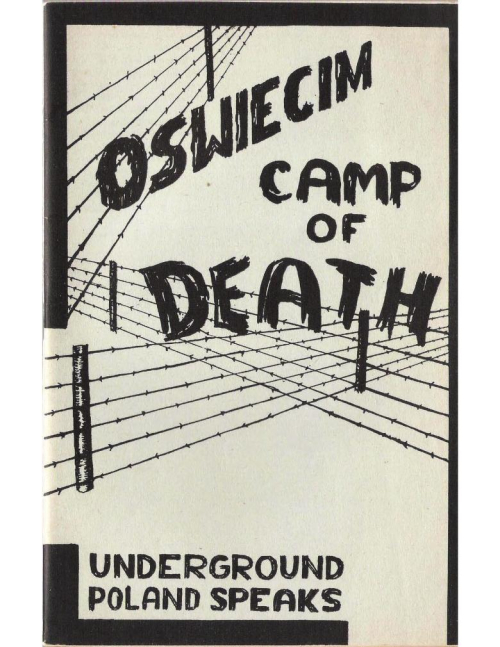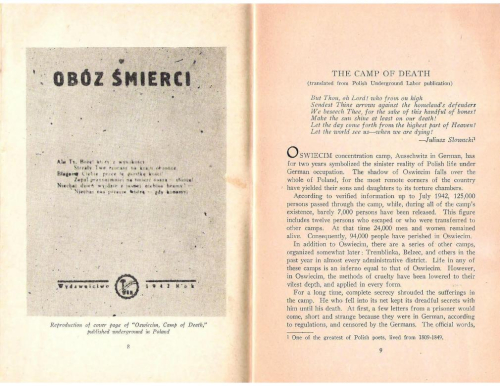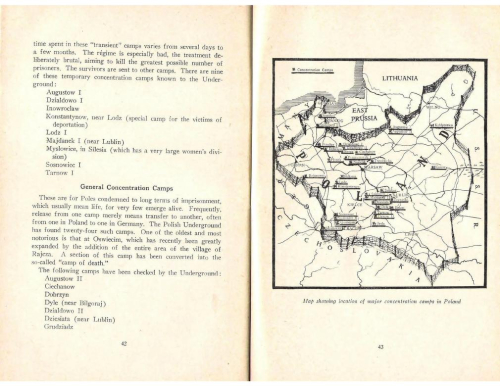JF Ptak Science Books Post 2788
 I stopped by my old friend the amazing Andy Moursund’s fantastic Flickr site, where in just the first 30 seconds or so I needed to stop and follow Andy’s lead on an astonishing book. The cover1 is stark, and justifiably so as Oswiecism—Camp of Death. (Underground Report)2 is one of the earliest separately published reports on Auschwitz, published in March, 1944. (Auschwitz, which is the German rendition of the Polish "Oswiecism", comes into being in May 1940, grows by 140,000 prisoners in March 1941, another 200,000 in 1942, and then many more until the end, when something on the order of 1.1 million people were murdered there, 90% of them being Jewish.)
I stopped by my old friend the amazing Andy Moursund’s fantastic Flickr site, where in just the first 30 seconds or so I needed to stop and follow Andy’s lead on an astonishing book. The cover1 is stark, and justifiably so as Oswiecism—Camp of Death. (Underground Report)2 is one of the earliest separately published reports on Auschwitz, published in March, 1944. (Auschwitz, which is the German rendition of the Polish "Oswiecism", comes into being in May 1940, grows by 140,000 prisoners in March 1941, another 200,000 in 1942, and then many more until the end, when something on the order of 1.1 million people were murdered there, 90% of them being Jewish.)
See Andy's site here: https://www.flickr.com/photos/145907841@N08/albums/721577056751817750
I checked the title on the internet archive, where there is a full-text copy available to read (here:
https://archive.org/details/OswiecimCampOfDeath/page/n1
Reading this pamphlet is a very stiffening experience, even if you have a background in reading about the Holocaust.
I imagine too that this may be one of the earliest appearances in print of the hellish sign at the entrance to the KZ, “Arbeit Macht Frei” (“Work Brings Freedom”).
We read of it on page 24 of the pamphlet:
“HERE is a large sign over the camp entrance with the words "Arbeit Macht Frei", ("Work Brings Freedom"), while from any spot in the camp one can see the huge chimney of the crematory. It is an ugly, brownish red.”
“A prisoner's life moves between these two points — the sign and the chimney —from the moment he "loses" his life when he enters the camp until the moment he "regains" it as a bit of ashes coming from the crematory.”
“Surrounding the camp for an area several miles in width are cultivated fields from which the previous owners have been evicted. Many farm buildings and workshops adjoin the camp and its barracks. Scores of miles beyond the actual camp boundaries are the coal mines. All work, above ground or underground, is done by prisoners. They till fields, build houses, mine coal, load and unload trains. They produce goods of which only a part is for the camp; the major share goes to the German army…”
And of further interest is this map of concentration camps in Poland:
Notes
- Cover by Teresa Zarnower (Teresa Żarnowerówna was a Polish avant-garde artist, painter, sculptor, scenographer, and architect). “One of the most important artistic personalities of the Polish constructivist avant-garde in the 1920s…” (Jewish Women’s Association Archive)
- Oswiecism—Camp of Death. (Underground Report), Sponsored by NATIONAL C.I.O. War Relief Commission, First Edition: March 1944. Copyright 1944 by Poland Fights New York, N. Y. Sponsored by American Friends of Polish Democracy; Published by Poland Fights, 55 West 42 Street, New York 18, N. Y. Assisted by Polish Information Center





Comments